Lichen Systematics, Groups, and Biogeography
1/48
There's no tags or description
Looks like no tags are added yet.
Name | Mastery | Learn | Test | Matching | Spaced |
|---|
No study sessions yet.
49 Terms
Where did scientific names originate?
Carolus Linnaeus in 1735 proposed that every organism should have a unique two-part name, a binomial (scientific name and species). This system is still used today.
Hierarchy: Domain → Kingdom → Phylum → Class → Order → Family → Genus → Species
How do the patterns of naming differ/relate between plant and fungal suffixes?
Phylum and Class are easier differentiated between for “my” in fungal endings and “phy” in plant endings.
Taxonomy | Plant Endings | Fungal Endings |
Phylum | =phyta | =mycota |
Class | =opsida | =mycetes |
Order | =ales | =ales |
Family | =aceae | =aceae |
What is the "authority" in a scientific name?
The authority is the surname of the person who first described the species. In plants, it is usually abbreviated. If a species is reclassified into a different genus, the original author is placed in parentheses, followed by the author who made the new combination.
Example (Reindeer Lichen):
Lichen rangiferinus L.
Cladonia rangiferina (L.) Weber
Cladina rangiferina (L.) Nyl
Cladonia rangiferina (L.) Weber ex F.H. Wigg
How did Linnaeus treat lichens in his classifications?
Linnaeus regarded lichens as “rustici pauperrimi” (poor little peasants of nature) and treated them somewhat arbitrarily. He only named five species outside of Europe, which is just 5% of the region's lichen flora, often providing only a brief diagnosis without further description.
Most lichens he described were common and widespread, from genera like Cladonia, Lecidea, Lobaria, Parmelia, Peltigera, Ramalina, and Usnea. His herbarium contains 324 sheets, but only 93 can be directly attributed to him, with many contributions from his son. Some collections lack annotations beyond their epithet and cannot be used as type specimens.
How is lichen nomenclature determined?
Lichen appearance and structure are primarily determined by the genetic information of the fungal component. Almost every recognizable lichen originates from a unique species of lichenized fungus.
Following nomenclature rules, lichens are named after their fungal component. For example, Cladonia cristatella refers to the fungus in the lichen, while its photobiont, the green alga, has a separate name (Trebouxia erici).
What is the history and classification of the genus Parmelia (Shield Lichens)?
Historically, Parmelia included over 1,000 species, but taxonomic revisions in the 1970s reclassified many.
Sensu lato refers to Parmelia in a broad sense.
Sensu stricta refers to its narrower classification.
In North America, Parmelia species were reduced to about 10.
Related Genera:
Parmotrema (Ruffle Lichens)
Rimelia (Cracked Ruffle Lichens)
Hypotrachyna (Loop Lichens)
Punctelia (Speckled Shield Lichens)
Cetrelia (Sea-Storm Lichens)
Platismatia (Rag Lichens)
Xanthoparmelia (Rock Shield Lichens)
Flavoparmelia (Greenshield Lichens)
Flavopunctelia (Speckled Greenshield Lichens)
What are the key characteristics of Hypogymnia (Tube Lichens)?
Non-Parmelia Foliose
Have narrow, inflated tube-like lobes
Some species feature "powder head" lobes with soredia
When opened, the tubes have a distinct ceiling and floor, with their colors being important for species identification
The Latin root “physia” means inflated
What are the key characteristics of Anaptychia (Shaggy Fringed Lichen)?
Non-Parmelia Foliose
Has narrow lobes
Ecorticate thallus (lacks a lower cortex, so it is not a shield lichen)
Features laminal apothecia and lobulate growth
What are the key characteristics of Heterodermia (Fringed or Centipede Lichen)?
Narrow lobes, often with a fringed or centipede-like appearance
Lower thallus is often ecorticate (lacking a lower cortex)
Upper surface is usually gray to whitish and may have soredia or isidia
Frequently found in humid or coastal environments
Typically grows on trees, rocks, or soil
Some species exhibit distinctive blue-green or yellowish tints due to secondary metabolites
Non-Parmelia Foliose
What are the key characteristics of Xanthoria (Sunburst Lichens)?
Contains anthraquinones (specifically parietin)
K+ reaction: turns purple
Has polarocule spores
Belongs to the family Telioscistaceae
Non-Parmelia Foliose
What are the key characteristics of Candelaria (Candleflame Lichens)?
Contains vulpinic acid
K- reaction: turns light pink or sometimes K+ light pink
Non-Parmelia Foliose
What does "ecorticate" mean in lichen classification?
"Ecorticate" refers to a lichen that lacks a distinct cortex (outer layer of fungal tissue). These lichens do not have the protective cortex that most foliose and fruticose lichens have.
Examples of ecorticate lichens:
Filamentous
Byssoid
Leprose
Gelatinous
What are the two main broad-lobed foliose lichens mentioned in class, and what are their characteristics?
Peltigera (Dog or Pelt Lichens):
Dog (tomentose) or pelt (smooth and shiny) appearance
Lacks a lower cortex, giving it a felty texture with visible "veins"
Many species contain cephalodia with a cyanobiont
Typically terricolous, but can also grow on trees with moss
The lower surface is ecorticate and may appear arachnoid-like (spiderweb-like) or tomentose
Lobaria (Lungwort/Lung/Lettuce Lichens):
Tomentose occurs in the veins of the lichen
Often has a leafy or lobed appearance resembling lung tissue
What are the key characteristics of Umbilicaria (Rock Tripe), Lasallia (Toadskin Lichen), and Dermatocarpon (Stippleback/Leather Lichen), aka our umbilicate lichens?
Umbilicaria (Rock Tripe):
Features a central holdfast
Dark thallus with apothecia (if present) and sterile tissue bands
Lecideine apothecia are gyrose, with sterile ridges
Thalloconidia/Thallospores: Black reproductive propagules found on the bottom, giving the lichen a velcro-like appearance
Has trabeculae, plate-like structures that radiate from the umbilicus (central attachment point) on the lower surface
Chemistry: Typically lacks pigments, but contains gyrophoric acid (C+ red)
Spores are muriform (brick wall or corn ear-shaped)
Umbilicaria is distinguished from Lasallia by its ascus having multiple spores, while Lasallia has 1-2 large, muriform spores per ascus
Lasallia (Toadskin Lichen):
Contains 1-2 large, muriform spores per ascus
Features pustules on the upper side of the thallus, which are raised and hollow below
Dermatocarpon (Stippleback/Leather Lichen):
Has perithecium ascomata (fruiting body)
Typically grows slightly submerged in its environment
What are the key characteristics of Jelly Lichens and the genera Collema and Leptogium?
Jelly Lichens:
Foliose lichens with a primary cyanobiont
Have a gelatinous texture when wet
Color ranges from slate to dark black, brown, or olive
Collema (Jelly/Tar Paper Lichen):
Has a gelatinous texture when wet, often resembling tar paper
Typically grows in moist environments
Leptogium (Jellyskin):
Also exhibits a gelatinous texture when wet, but often described as resembling jellyskin
What are the main groups of foliose lichens?
Parmelia
Non-Shield Lichens
Broad Lobed
Umbilicate
Jelly
What are the main groups of fruticose lichens?
Greenish-Yellow
Subfruticose
Squamulose
Can be a part of a two-part lichen
What are the general characteristics of a fruticose lichen?
Thallus: Usually erect or prostrate on horizontal surfaces, or pendent on vertical surfaces.
Growth form: Can be bushy, tufted, or pendant.
Structure: Often has a central axis or cord (in some species), which acts as support.
Reproductive features: Frequently has podetia (branched stalks) or pseudopodetia, which are reproductive structures like apothecia or pycnidia.
Texture: Generally tough and can have structures like soredia, isidia, or soralia.
What are the characteristics of the "Greenish Yellow" fruticose lichens, Ramalina (Strap Lichen) and Usnea (Beard Lichen)?
Ramalina (Strap Lichen):
Branches are flattened with a uniform medulla.
Thick cortex with support tissue, making it tougher than Usnea.
Often has pseudocyphellae.
Cortex: Two-layered, KC+ yellow.
Usnea (Beard Lichen):
Branches have a central cord (axis) and are terete (round).
Central axis serves as the support for the lichen.
Medulla can be pigmented.
Photobiont layer is highly variable around the medulla.
It can have soralia, soredia, isidiomorphs, annular cracks, and regeneration beads.
Pendent Species: U. ceratina
Bushy/Tufted w/ Apothecia: U. strigosa
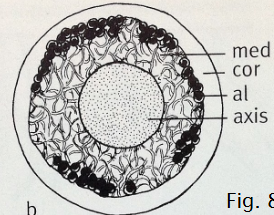
How do you calculate the CMA (Cortex-Medulla-Axis) ratios in lichens?
To calculate the CMA ratios, use the following formulas:
Cortex ratio: (Cortex x 2) / Total diameter x 100
Medulla ratio: (Medulla x 2) / Total diameter x 100
Axis ratio: Axis / Total diameter x 100
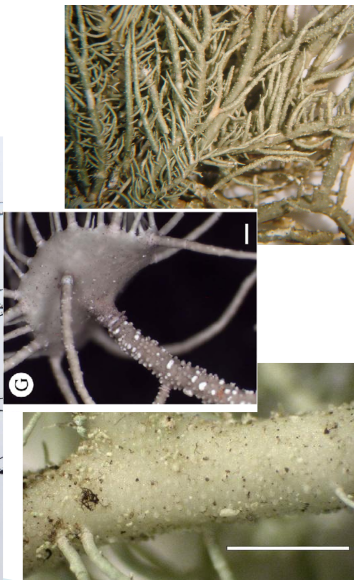
What are fibrils, tuberculae, and papillae in Usnea and other lichens?
Fibrils: Short branches perpendicular to the main filament, largest branches, and contain all three internal layers.
Tuberculae: Wort-like protuberances with medullary tissue, characteristic of Usnea ceratina and Ramalina paludosa.
Papillae: Small, rounded bumps on the cortex of lichens, particularly Usnea. They do not contain medullary tissue and resemble goosebumps.
What are soralia and isidomorphs in lichens?
Soralia: Areas of a thallus where the cortex breaks down or cracks, and soredia are produced. They can appear in various forms and may sometimes contain isidia along with soredia (e.g., in Lobaria pulmonaria and Usnea diplotypus).
Isidiomorphs: Isidia-like outgrowths that form from the soralium. These resemble true isidia but differ because they arise specifically from the soralium, not the main thallus.
What are isidia in lichens?
Isidia: Minute thalline outgrowths that are corticate (have a cortex) and contain photobiont cells.
They are easily detached from the thallus and serve as vegetative reproductive units, helping the lichen propagate.
What is a pustule (or "pustulate") in lichens?
Pustule: A hollow, wart-like or blister-like structure found in lichens, especially in Lasallia.
Described as broad and raised, or verruca.
What are subfruticose lichens and their characteristics?
Subfruticose: Lichens that have a growth form intermediate between fruticose (branching, upright, usually on vertical surfaces) and foliose (leaf-like, flat, often attached by one side).
These lichens typically have lobes that are smaller than those in fruticose lichens (often <25mm) and are often shingle-like or partially attached.
Their lower thallus is often ecorticate, meaning it lacks the usual protective cortex found in most lichens.
Example: Pseudovernia (Antler Lichen) is a subfruticose lichen known for its antler-like shape.
What are two-part lichens and their characteristics?
Two-Part Lichens: Lichens with primary and secondary thalli.
Primary Thallus: Horizontal (often crustose or squamulose).
Secondary Thallus: Vertical (fruticose), typically with podetia or pseudopodetia.
Fruticose: Secondary thallus forms branches that serve as reproductive structures, often associated with apothecia (sexual reproductive bodies) or pycnidia (asexual reproductive bodies).
Examples:
Cladonia (e.g., Pixie-cups, Reindeer lichens, British Soldiers, Peg/Thorn lichens): Known for podetia (branched, upright structures).
Cladonia cristatella: Commonly known as British Soldier.
Cladonia carneola: Known as Pixie Cup.
What are the different types of crustose lichens?
Leprose: Powdery/granular, with loosely organized clumps of fungal hyphae and photobiont cells. No defined thallus boundary.
Continuous: Thallus has very few breaks.
Rimose: Cracked with narrow, shallow fissures. Develops from a continuous thallus.
Lobate: Marginal areas more developed than the center, sometimes appearing foliose at the edges.
Areolate: Thallus breaks into separate, defined sections (areoles) with photobiont cells on both the upper surface and sides.
Bullate: A rounded, bumpy variant of an areolate thallus.
Endosubstratal: Grows within the substrate (wood, rock), with photobiont cells just beneath the surface. Often appears as only slight discoloration.
What is a prothallus, and how does it differ in crustose and foliose lichens?
Prothallus: A pigmented, non-lichenized hyphal layer forming a basal (hypothalline) structure.
In crustose lichens, it appears as a dark fringe around the thallus margin, often extending slightly ahead of the main lichen body.
In foliose lichens, this structure is often called the hypothallus and serves a similar function at the base of the lichen.
What are sterile crustose lichens, and how do they reproduce?
Sterile crustose lichens lack reproductive structures like apothecia or perithecia.
Common in leprose and continuous lichens.
Example: Dibaeis (when sterile).
The primary crustose thallus often contains verrucae (wart-like structures).
These verrucae gradually break down into schizidia (small, asexual propagules) that aid in reproduction.
What are disk lichens, and what characterizes their apothecia?
Disk lichens have apothecia that are disk- or cup-shaped with an exposed hymenium. They can be categorized based on the type of margin:
Lecanorine (Thalline) Apothecia – have a distinct thalline margin.
Lecideine Apothecia – lack a thalline margin, often appearing black or sunken.
What are the key features of Lecanora sensu stricta?
Known as “Rim Lichens” due to their distinct thalline (rimmed) apothecia.
Apothecium margin is well-defined.
Ascospores: Simple (single-celled), hyaline (colorless).
How can you identify Ocrolechia species?
Characterized by wheel-like thalline apothecia.
Ascospores are large and thin-walled.
Thallus is crustose, colored gray to blue-gray.
Historically used to produce Cudbear, a purple dye.
What are the characteristics of Aspicilia species?
Thallus is gray, ranging from continuous to rimose (cracked) or areolate (divided into blocks).
Apothecia are black, sometimes flushed or sunken into the thallus.
May have a prothallus (a distinct margin of fungal growth around the main thallus), but this varies (+/-).
What are some lichens with lecideine (rimless) apothecia?
Buella stillingia ("Button Lichen")
Porpidia ("Boulder Lichen")
Which lichens have lecanorine apothecia that are submerged in the thallus (cryptolecanorine)?
Their apothecia are embedded in the thallus, making them harder to distinguish at first glance.
Dimelaena oreina ("Moonglow Lichen")
Acarospora novomexicana
What are the features of Pertusaria (Wart Lichen)?
Apothecia are immersed in warts, which are modified thalline margins.
Has thick-walled, large ascospores.
Thallus is crustose gray in appearance.
Cortex is C- (indicating it doesn't react to potassium hydroxide).
What are Script Lichens?
Characterized by lirellae (elongated apothecia).
Grow primarily on bark (endophloedal).
What does endophloedal growth mean?
Lichens that grow within the bark, often not visible on the surface.
What are lirellae apothecia?
Elongated, lecithin-shaped apothecia.
Exciple (outer margin) is absent.
What are the features of Arthonia lichens?
Variable apothecia:
Reddish-brown or irregular-shaped lirellae.
Tiny red apothecia in some species.
Spores: 3-4 cells.
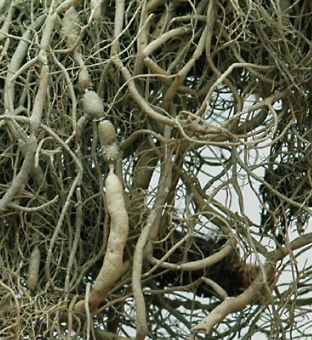
What are annular cracks?
Definition: Annular cracks are circular or ring-like splits that form in the thallus of certain lichens. These cracks typically appear as the lichen grows and can be a sign of thalline stress or desiccation.
Cause: They usually form due to changes in moisture levels, temperature fluctuations, or the aging process of the lichen.
Function: They can indicate the lichen's ability to adjust to environmental conditions, as well as its method of growth or expansion.
What are regeneration beads?
Definition: Regeneration beads are small, bead-like structures that form on the thallus, typically near cracks or damaged areas.
Cause: These beads develop as a form of asexual reproduction. When a lichen experiences physical damage (like cracking), the lichen can regenerate new growth by forming these beads.
Function: Regeneration beads serve to propagate the lichen, allowing it to recover and potentially colonize new areas. They contain reproductive propagules like soredia or isidia.
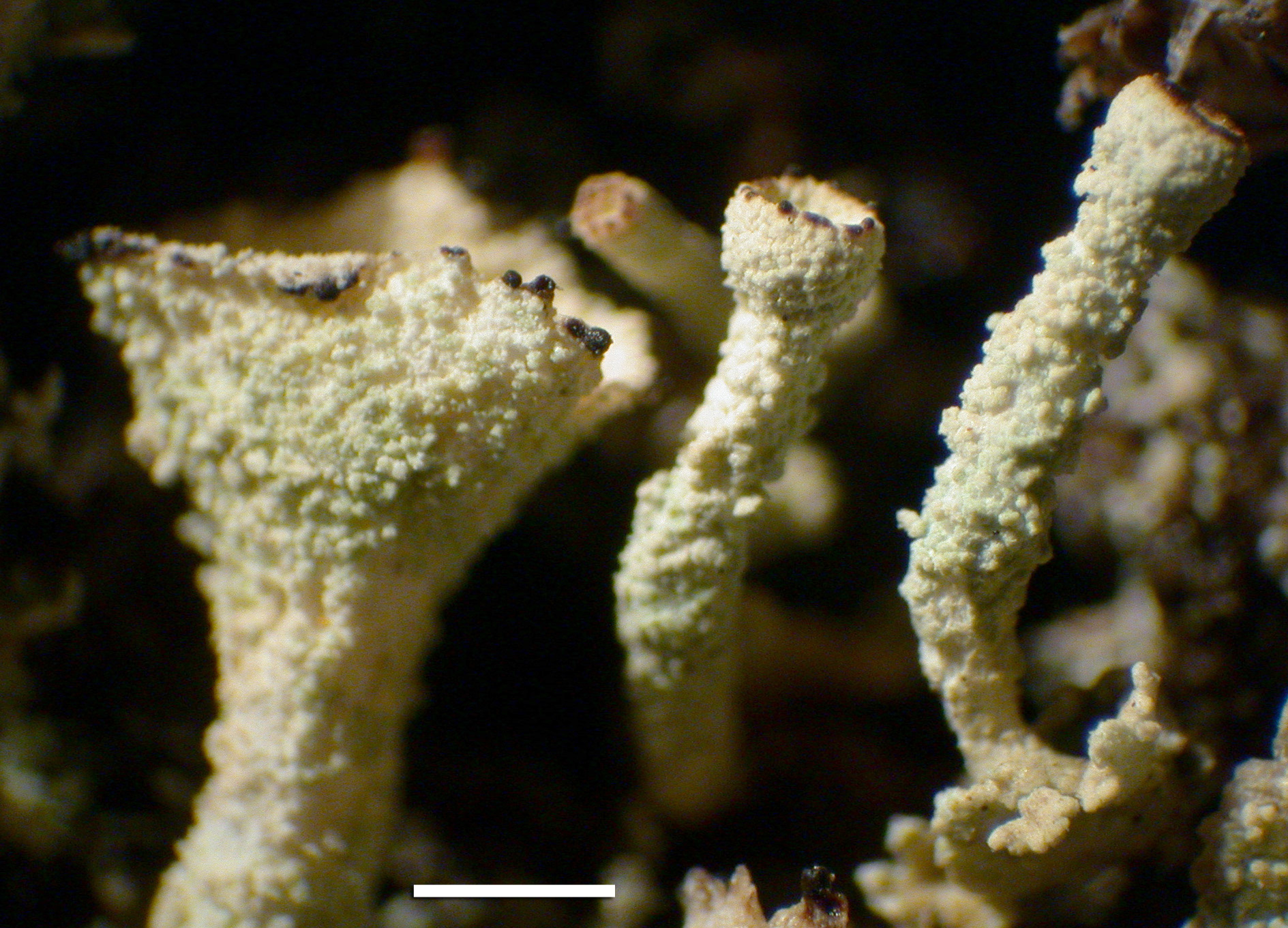
What are podetia?
Stalks that form from apothecia or pycnidia.
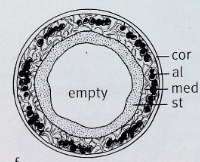
What are stereomes?
The stereome refers to a specialized, structural layer of tissue within the thallus that provides mechanical strength and support. It is typically made up of compact, tightly interwoven fungal hyphae. This layer is often found in foliose (leaf-like) or fruticose (shrub-like) lichens and plays a role in maintaining the integrity and rigidity of the thallus.
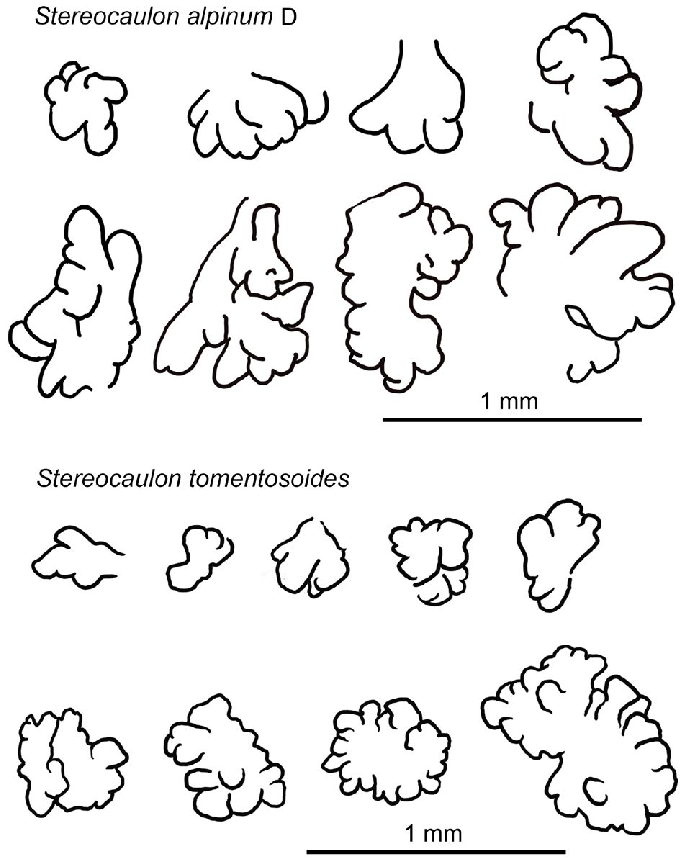
What are phyllocladia? What genera are they seen in?
Stereocaulon. They are lobed squamules that appear granule like or coralloid, surrounding the stalk.
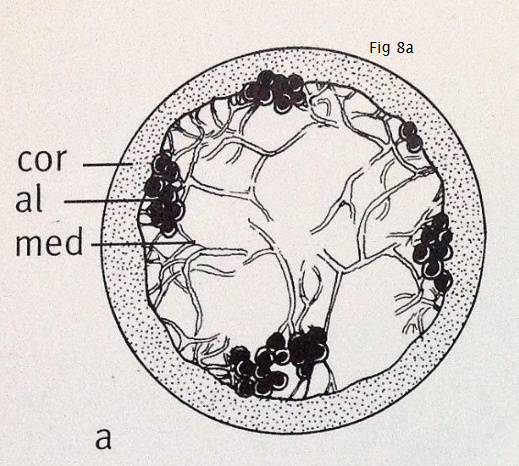
How do the branches of bryoria differ from usnea?
Usnea has a central axis, while bryoria does not. Bryoria has medulla in the center. Generally flattened pseudocyphellae are on the cortex.
What’s the difference between podetia and pseudopodetia?
Podetia are true, rigid stalk-like structures in fruticose lichens. They have a central axis made of compact fungal hyphae. This axis is surrounded by a cortex (the outer protective layer) and a medulla (the inner layer, often spongy, that helps with water retention).
Cladonia rangiferina (reindeer lichen): A well-known species where podetia form the stalks holding reproductive bodies.
Cladonia cristatella: Another species of Cladonia that features podetia as upright stalks.
Pseudopodetia are false podetia. They are branch-like or lobed structures that resemble podetia but lack the well-defined central axis. Instead of having a distinct stalk, pseudopodetia are often more flexible and flattened, originating from a crustose thallus. The medulla is still present but usually more disorganized.
Cladonia pyxidata: A species with pseudopodetia that resemble flattened, branch-like forms.
Cladonia deformis: Another species where pseudopodetia are found, often appearing as lobed or branching structures.
Key Differences:
Axis:
Podetia: Have a central axis—a rigid, supportive stalk.
Pseudopodetia: Lack a true axis; they are more branch-like or lobed.
Rigid vs. Flexible:
Podetia are rigid and stalk-like, providing structural support for reproductive structures.
Pseudopodetia are more flexible and may appear flattened, branch-like, or lobed.
Internal Structure:
Podetia have a well-organized cortex and medulla, with a clear axis.
Pseudopodetia have a less defined internal structure and are usually disorganized in terms of their hyphal arrangement.
What is the difference between a stereome and a podetia?
A podetia is the upright, hollow, stalk-like structure that forms the secondary thallus. The stereome is the inner translucent layer of the stalk, and is tissue that makes up the inner part of the stalk, especially in species that lack a cortex. It surrounds the empty stalk, giving it structure, while the podetia is the stalk itself. As explained by the textbook, in the stalks (podetia) of Cladonia species, the innermost portion of their medulla forms a more or less complete cartilaginous cylinder called a stereome.
What are the six types of crustose lichens?
Leprose
Continuous
Rimose
Lobate
Areolate
Endosubstratal